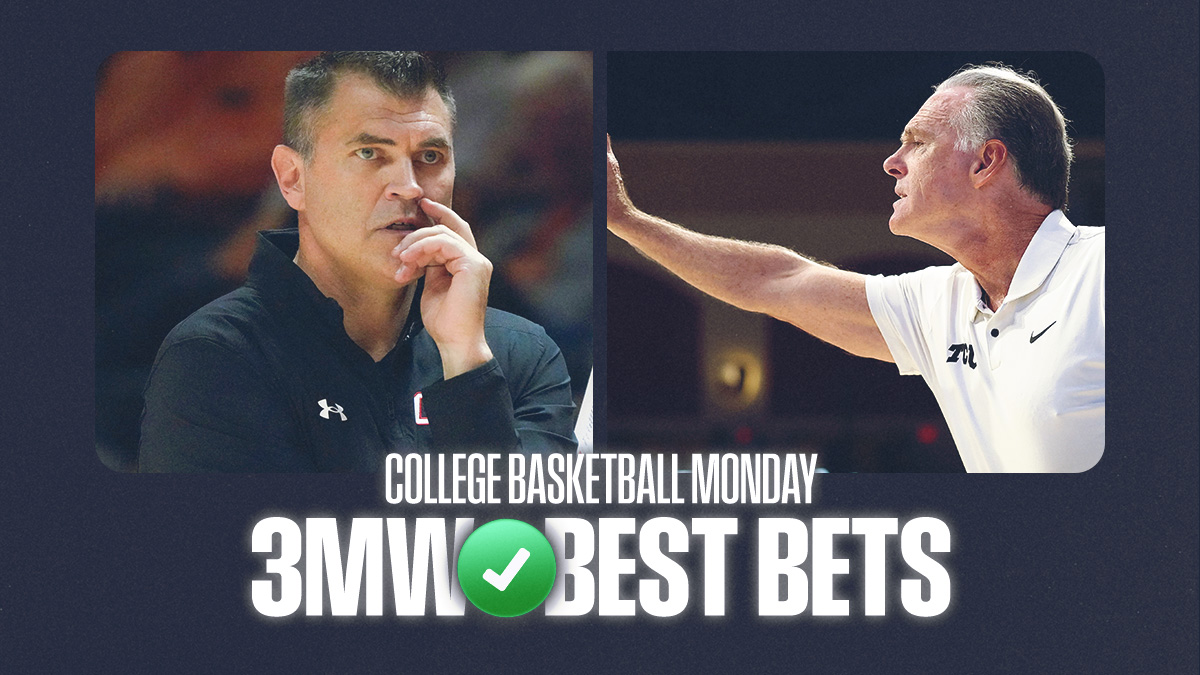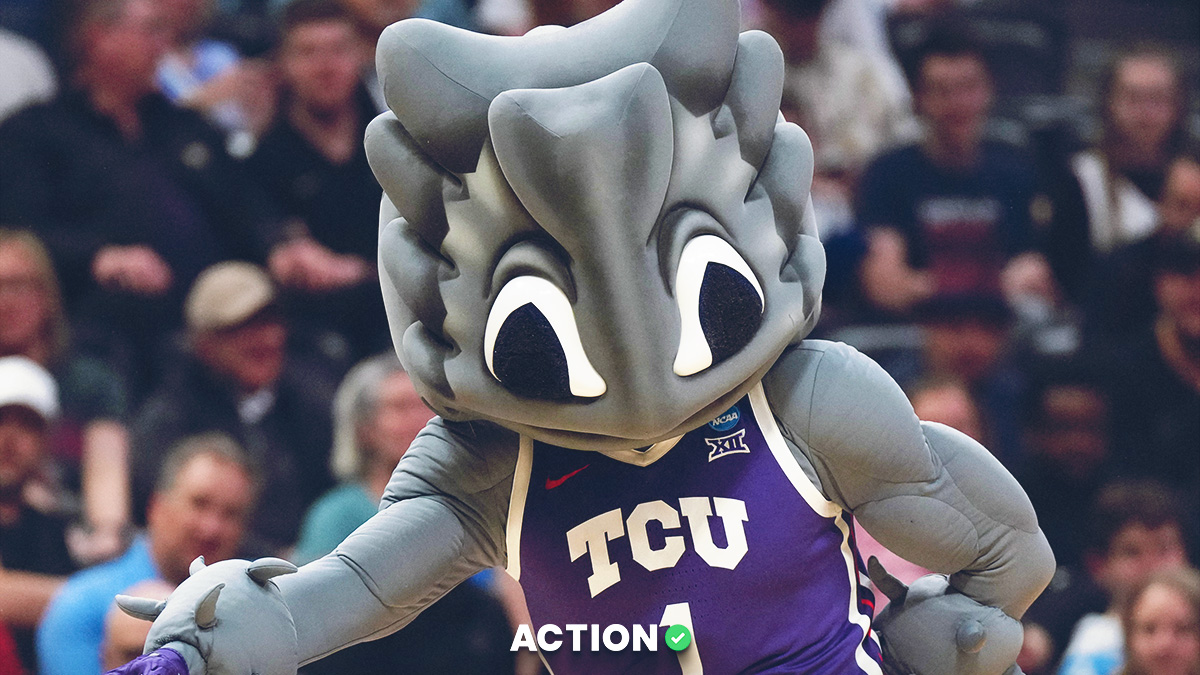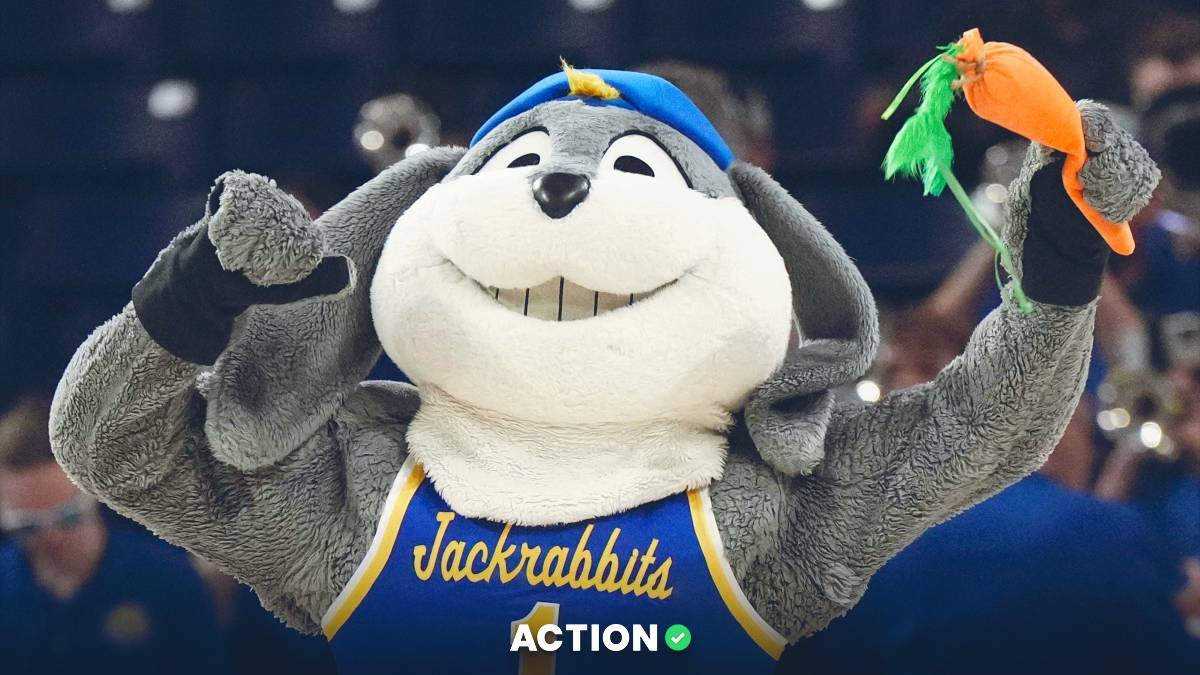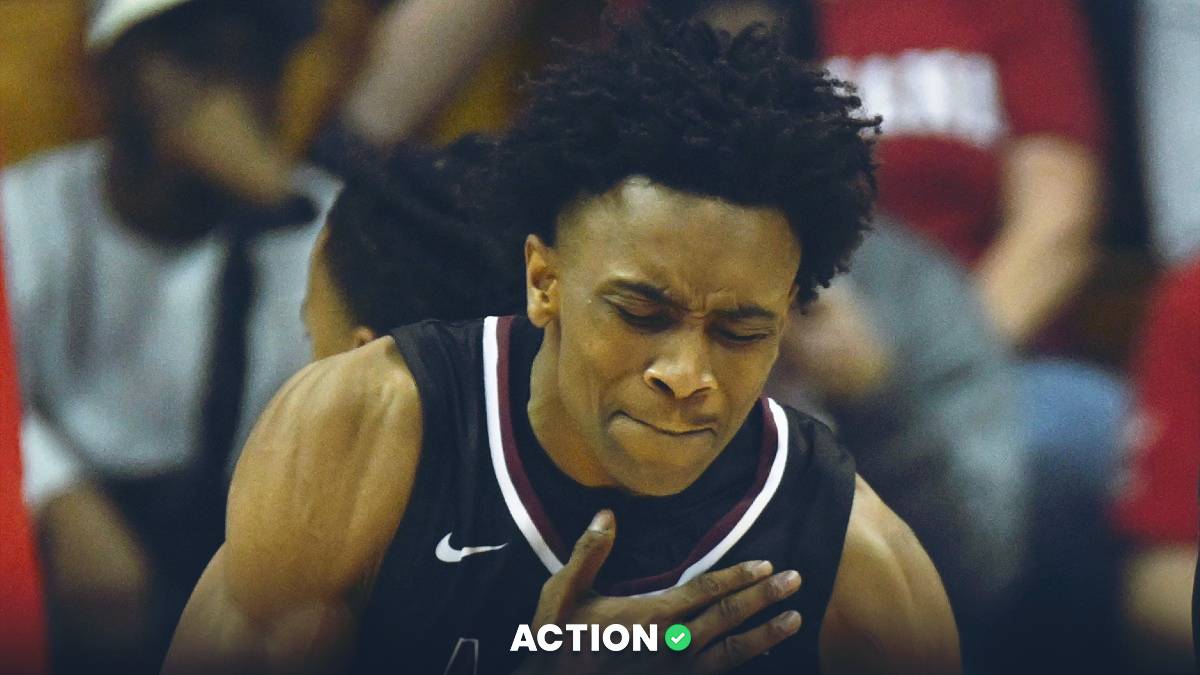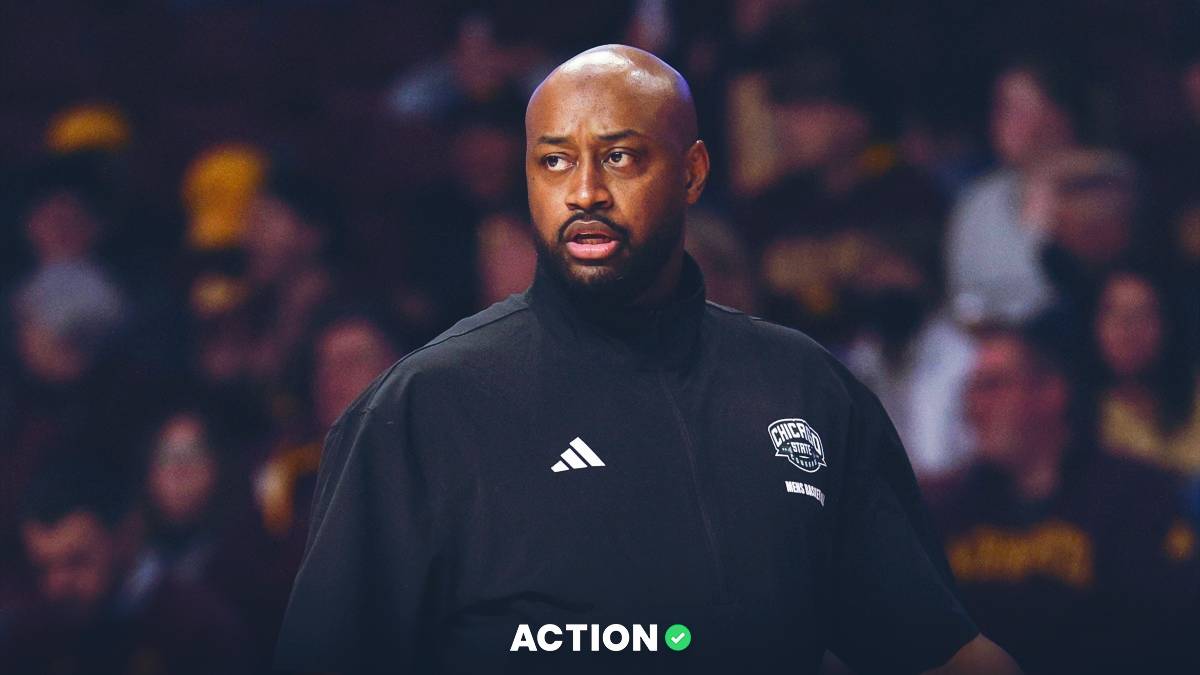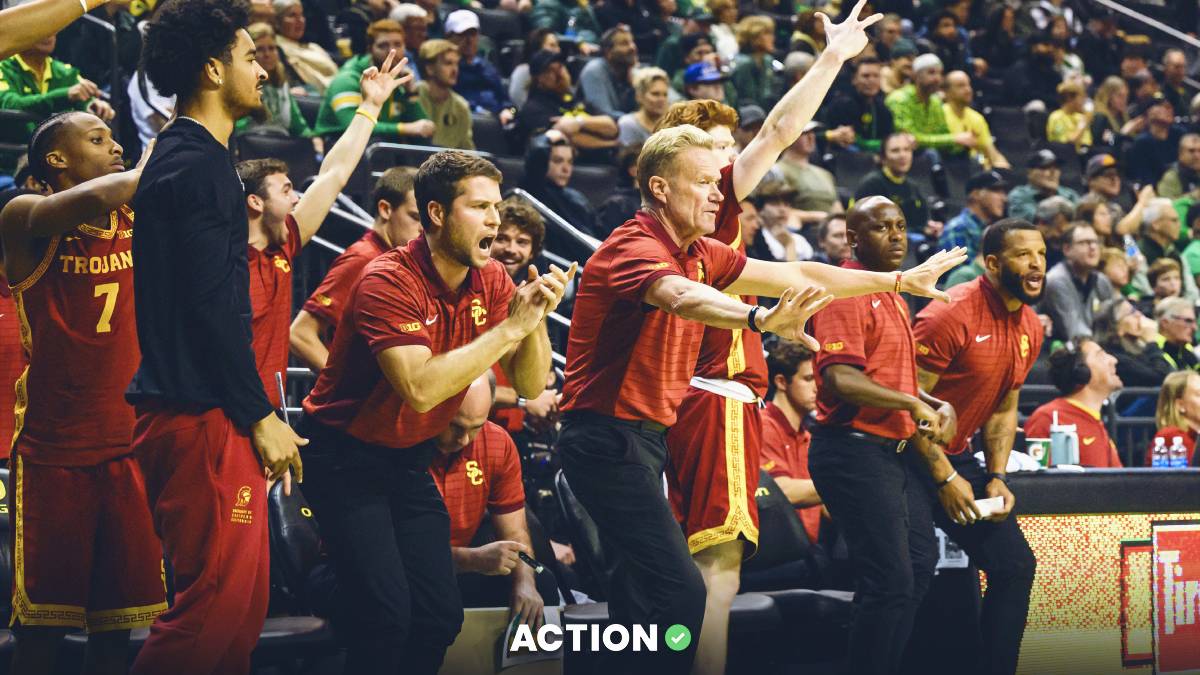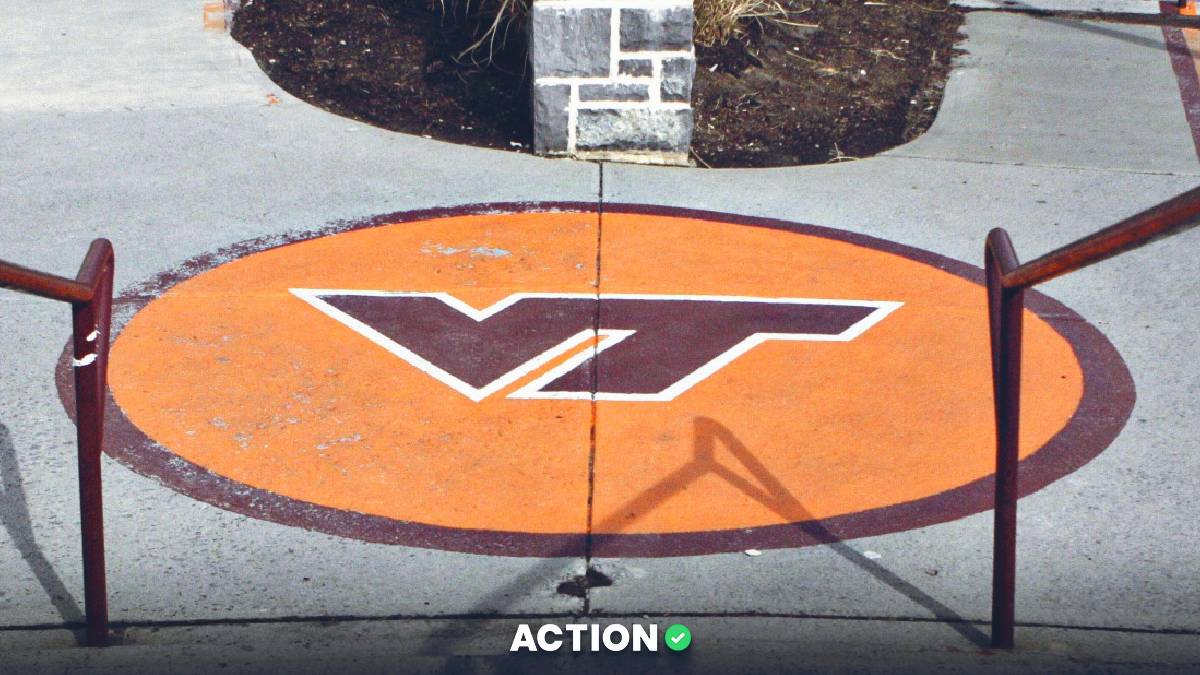I wrote about Creighton’s infamous KalkDrop for my last Film Review column.
Drop coverage is the most passive way to defend ball screens. Perimeter defenders overplay ball-handlers on the perimeter and wing, funneling them towards a dominant rim protector who sags, or drops, toward the rim instead of defending at the level of the screen.
Ultimately, the scheme baits ball handlers into taking awkward, inefficient mid-range shots over the drop.
Here's a great breakdown of some drop-coverage schemes from Jordan Sperber of Hoop Vision:
I highly recommend reading my aforementioned article to understand more about drop coverage.
As in this Film Review, I’ll discuss the opposite – the most aggressive way to defend ball screens, via Houston and Iowa State.
Shout Outs
Much of my analysis here is helped by Jordan Sperber of Hoop-Vision. I can’t overstate how elite his college hoops schematic coverage is, so please follow him on Twitter and watch his YouTube.
Similarly, I often reference Jordan Majewski’s blog in my work, Staring at the Floorboards. This is a great source.
Finally, I’m sure you all subscribe to KenPom, the college basketball bible. But I highly recommend reading his Substack, kenpom’s thoughts. Thanks for some Houston knowledge, Mr. Pomeroy.
Ball Screen Blitzing
In this ball-screen coverage, instead of sagging towards the rim, the screener’s defender aggressively attacks the ball-handler, double-teaming or “trapping” him (although it's worth mentioning that Coach Kelvin Sampson doesn't like the term "trapping" to define this, per Mr. Sperber via The Athletic).

While drop coverage baits the ball-handler into taking shots, ball-screen blitzing forces the ball out of the handler’s hands by emphasizing on-ball pressure, pushing the ball-handler towards the half court. These defenses want you to generate offense from a secondary shot-maker or creator.
This has three effects.
First, it results in direct turnovers from the handler, mainly from quick-handed on-ball defenders.
Second, it baits ball handlers into tough passes to the roll man. But because the ball handler is double-teamed and forced on his heels towards the half-court line, easy roll-man passes turn into impossibly long ones that travel across the middle of the floor, and good ball-screen blitz defenses pick those off.
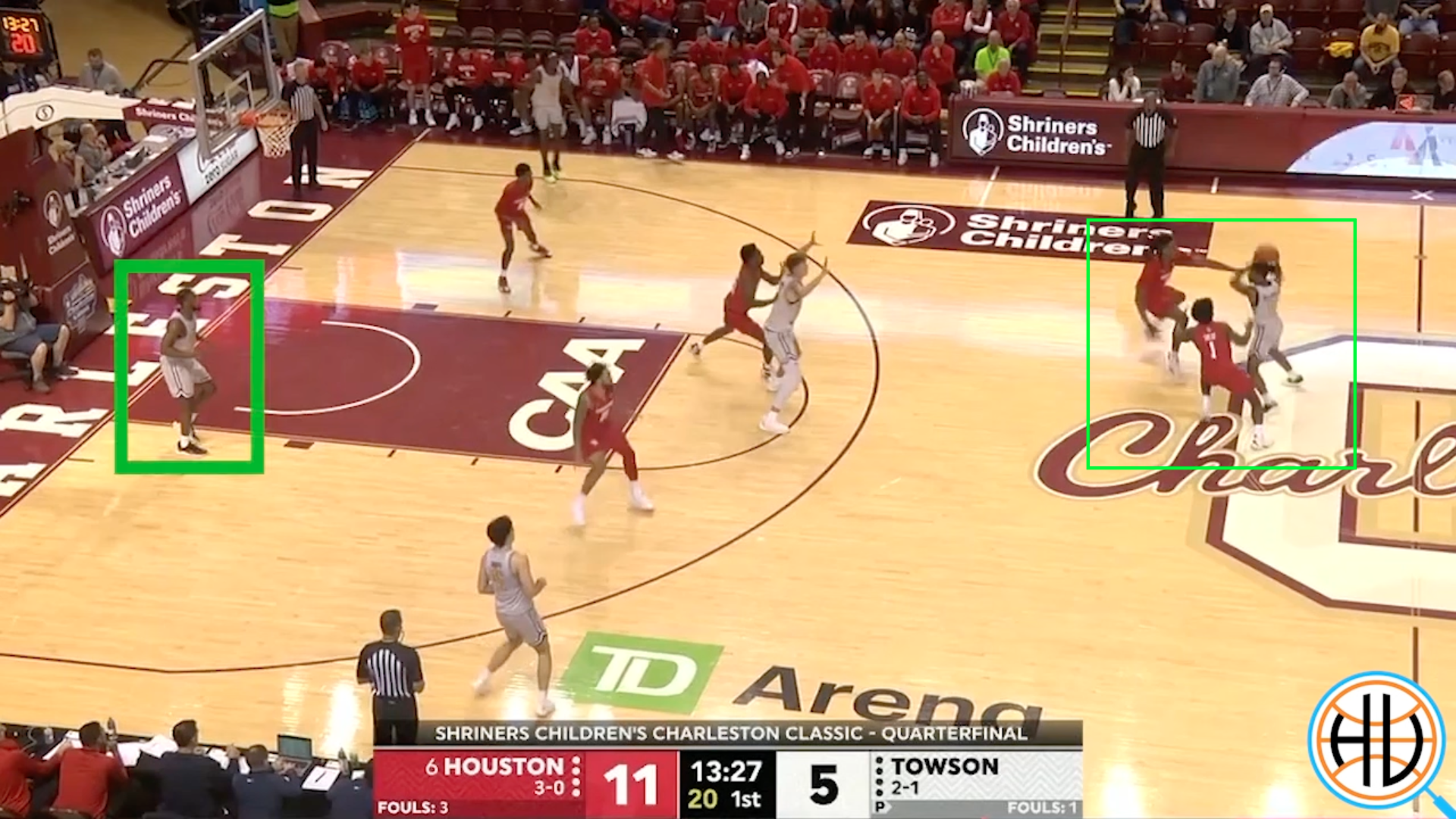
In many cases, ball handlers can’t even it to the open roll man, which is just as effective.
Deflections are key here. Good ball-screen blitz defenses will get in every passing lane and jump at every ball-handler, trying to force the ball off its desired line.
Check out the double-team on the wing and the double deflection into the steal and run-out dunk (second tweet in thread):
This is what good blitz defenses do.
Generally, these defenses are similarly aggressive in the paint, viciously denying the rim. So, even if the ball gets through to the roll man on a lengthy pass, he’ll be immediately covered by every defender in the area, and those guys will have ample time to recover on a long pass.
Sometimes, a third defender will leave a weak-side perimeter player to tag the roll-man while the on-ball defenders are blitzing, and the roll-man could swing the ball back out to the perimeter on short-roll passes. Still, they must process quickly against overwhelming pressure – a daunting task for college kids.
Third, it baits ball handlers into similarly impossibly long skip passes to corner 3-point shooters. Again, good ball-screen blitzes pick these off.

Or, the pass takes too much time, and the defense can easily recover to close out on the possible spot-up shooter.
Or, the pass is simply too difficult, and the passer throws the ball over the shooter’s head.
Here's an excellent example of a blitz forcing RaeQuan Battle into a dumb cross-court pass:
You can beat ball-screen blitz defenses with crisp skip passing and quick shooting. The aggressive nature of the scheme sends defenses into scramble mode on weak-side 3-point spot-up attempts – naturally, if you double-team the ball-handler, the rest of your defense has to rotate constantly once the ball starts moving.
Additionally, a good pick-and-pop big can beat the blitz, as he’ll be open while both ball-screen defenders latch on to the ball-handler. But, somewhat surprisingly, there aren’t that many legitimate pick-and-pop bigs in college basketball, so the risk is mostly minimized.
Drop-coverage defenses are passive, so those schemes generally force low turnovers and foul less but allow almost no 3-point or at-the-rim shots.
Ball-screen blitz defenses are aggressive, so those teams foul more and allow plenty of weak-side or pick-and-pop 3-point attempts, but they also force turnovers like crazy and sell out on rim denial, avoiding low-block buckets.
I’m not advocating for one scheme or the other, as each has its positives when well executed.
But let’s talk about two of the nation’s best ball-screen blitzes, which happen to double as two of college basketball’s best defenses.
The OG: Houston Cougars
No team is better at blitzing ball screens and relentlessly attacking ball-handlers than Houston.
As mentioned, I highly recommend checking out Hoop Vision’s work, as he did an excellent video on Houston’s league-best defense below.
Sampson has built a hyper-athletic roster, and he can leverage that athleticism in the blitz and recovery.
Per Sperber and via Synergy Sports, Houston forces the ball out of the handlers' hands on 71% of ball screens, the most of any high-major squad and far above the national average of 54%. Nobody blitzes the ball screen more.
And nobody does it better. The three main pick-and-roll ball-handler defenders are Jamal Shead, LJ Cryer and Emanuel Sharp, three of the nation’s best perimeter defenders – Shead ranks first among all collegiate players in EvanMiya’s Defensive Bayesian Performance Rating.
Here’s how those three shake out in ball-screen PPP allowed and steals per game.
| Player | Ball-Screen PPP Allowed | Steals Per Game | |
|---|---|---|---|
| Jamal Shead | .50 (90th percentile) | 2.2 | |
| Emanuel Sharp | .29 (98th percentile) | 1.5 | |
| LJ Cryer | .54 (86th percentile) | 1.1 |
As a result, Houston ranks third nationally in pick-and-roll ball-handler PPP allowed (.500). The Coogs allow only four points per game on the sets and force turnovers 31% of the time.
And, of course, they force steals on those lengthy skip passes. Deflections are so key. I’ll just re-insert the clip from above (again, second tweet in thread).
It’s beautiful.
As mentioned, the aggressive nature of the scheme results in scrambling on the interior and towards the weak side – rotations are key when you’re double-teaming.
That’s where Houston’s athleticism and activity shines.
J’Wan Roberts is among the best interior scrambling bigs I’ve seen. Even if the ball-handler can force in a tricky, lengthy pass over the trap and into the roll man, Roberts recovers too quickly and almost always gets his body in front of any big man.
And remember the name JoJo Tugler, the freshman backing up Roberts. He has an 11% block rate in limited minutes this year and could be the next great Houston scrambling rim protector once the starters move on.
Meanwhile, Ja’Vier Francis ranks second nationally in DBPR and 12th in block rate (11.2%). He’s among the best rim protectors in the nation, even when switched onto an island.
That brings up another, albeit less important, point.
A somewhat obvious way to circumvent ball-screen blitz defenses is by avoiding pick-and-roll sets altogether, leaning heavily into isolation creation.
The problem is that many college offenses don’t have great iso-ballers. And even if they do, Houston has three elite man-to-man defenders on the perimeter and two on the interior, so the team ranks 14th nationally in isolation PPP allowed (.58).
But, anyway, Houston’s bigs and wings will attack and pressure any guy who gets the ball on the interior. They’ll come down on you like Thor’s Hammer, viciously denying the rim. The Cougars allow the 18th-fewest post-up possessions per game (3.2) and the fourth-fewest post-up PPP (.59), while allowing the ninth-lowest near-proximity field goal attempt rate and ranking first in block rate (19%).
Here are a few good examples of Thor’s Hammer from Roberts. Texas A&M thinks it’s getting into the lane, but the Cougars aren’t going to let you off the hook that easy.
But, as mentioned, the classic way to beat the blitz is to spread the floor and target weak-side and pick-and-pop shooters, out-quicking the scramble with crisp passing and quick spot-up shooting. You can’t beat the Cougars with on-ball creation or post feeds. You have to shoot over ‘em.
Again, this is where the squad’s athleticism shines.
Houston ranks 327th nationally in 3-point rate allowed, but the Cougars close out on over 60% of them, ranking in the top 60.
The key is the fly-by. Instead of classically closing out with feet on the ground and a hand in the shooter’s face, Sampson’s defenders sprint toward weak side shooters and leap beside them with hands in the air.
I’m not exactly sure why it works better than classic close-outs, but my main theory is that it’s hard to shoot over Houston’s length and athleticism. Either way, the Cougars have held opponents under 30% shooting from 3 for six consecutive seasons.
All in all, you can’t score on Houston. The Cougars rank first nationally in defensive efficiency, first in eFG% allowed and third in turnover rate, allowing a nation-low 53 points per game.
Here’s a good breakdown of several Houston defensive sets, courtesy of Earl Lewis.
Mini-Houston: Iowa State Cyclones
Let’s get into the meat of our article.
You know about Houston’s league-best defense. You know the Cougars are a legitimate national title contender because of Sampson’s defensive wizardry.
But you might know a little bit less about Houston Jr.
I bought a little too much Iowa State stock a few months ago. I have Cyclones national title futures ranging from 125-1 to 100-1, mainly because of T.J. Otzelberger’s defense paired with an up-and-coming superstar point guard, Tamin Lipsey.
However, the more I watched Iowa State hoop, the more I realized the Cyclones are mini-Cougars.
The Cyclones are also an aggressive ball-screen coverage defense, albeit not as aggressive as Houston. Still, they’ll blitz and hedge more than most power six squads, as you can see below in this chart from our friend Mr. Sperber:
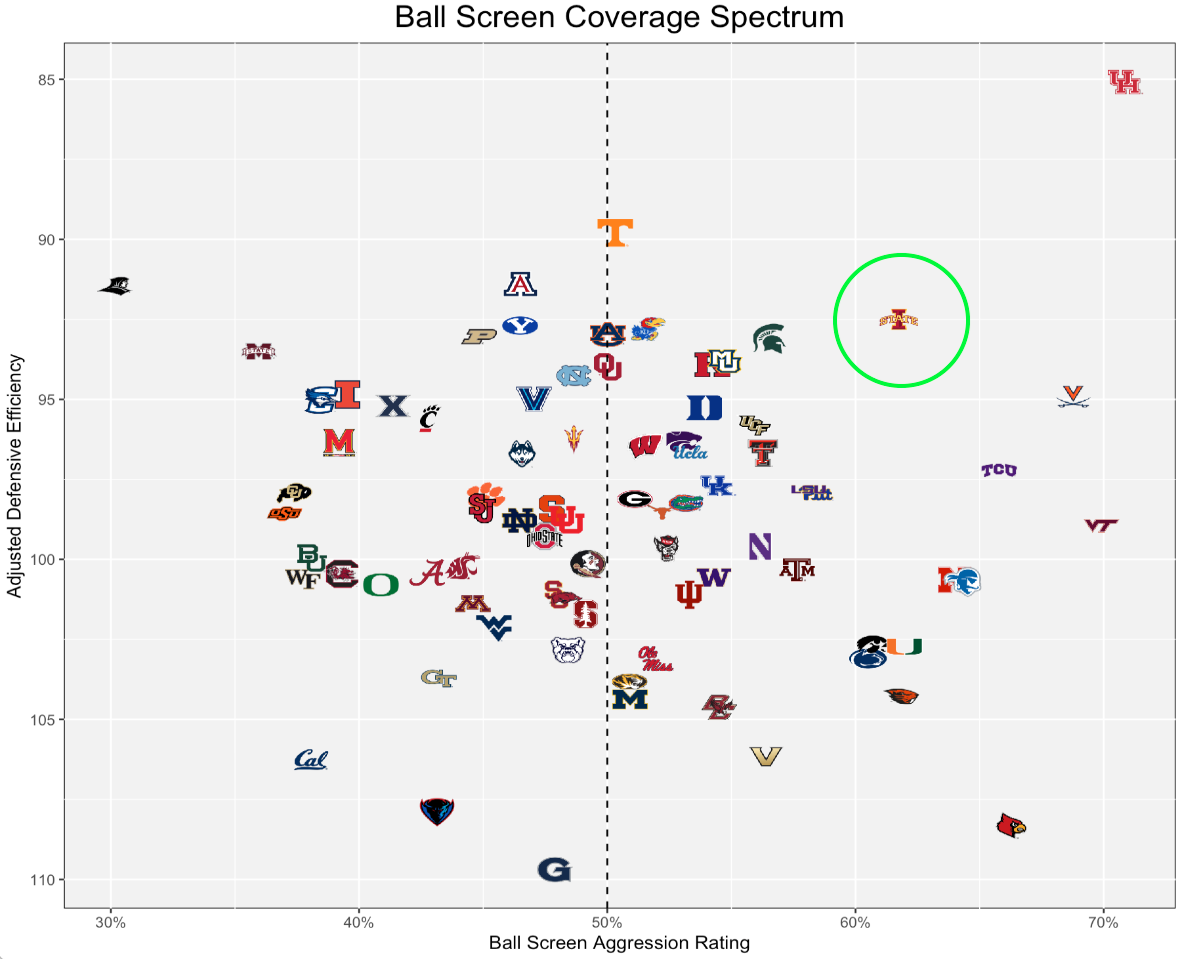
Again, the Cyclones are mini-Cougars. They’ll blitz and try to deny ball screens, forcing the ball to a secondary player, just not as aggressively as the nation’s most aggressive ball-screen blitz defense.
You can see they’re trapping Dajuan Harris Jr. here, but not quite as aggressively as Sampson’s team would:

However, Iowa State still forces turnovers and deflections at a high rate. In fact, the Cyclones lead the Big 12 in conference-only turnover rate, just above Houston.
Here’s Iowa State’s Hason Ward blitzing Houston’s Cryer and forcing the turnover – a little dose of your own medicine, eh Sampson?
Similar to Houston, Iowa State rosters three excellent defensive guards. Chief among them is Lipsey, who is, to me, Shead Jr.
The Cyclones' secondary guards are not elite on-ball blitz defenders, so it makes sense that they don’t blitz as aggressively as Houston. But Lipsey is turning into a superstar defensive guard, helping Otzelberger stymie opposing offenses at the point of attack. He’s recording over three steals per game.
Again, like Houston, Iowa State’s aggressive defense allows plenty of 3s. Unfortunately, the Cyclones don’t have Houston’s athletic depth – they are Houston Jr. for a reason – so their ability to close out on weak-side shooters is iffy.
They rank 254th in Open 3 Rate allowed and 344th in unguarded catch-and-shoot opportunities per game (11).
But, like Houston, Iowa State viciously denies the rim.
But the Cyclones do it better.
Iowa State ranks second nationally in near-proximity field goal rate allowed and 71st in at-the-rim PPP allowed (1.1). The Cyclones are first nationally in post-up possessions per game allowed (1.9).
In that regard, Robert Jones is Francis Jr. He doesn’t record gaudy block numbers. Still, his mere presence is enough to keep players away from the rim – Iowa State is five points per 100 possessions better with Jones on the court.
Check out this play: Jones is already anchoring the paint, mirroring TCU big man Ernest Udeh Jr. But as Micah Peavy drives the lane, Demarion Watson slides across the baseline to stop the first layup attempt, passing it to the other block, where Milan Momcilovic recovers and blocks Emanuel Miller's next attempt.
There are literally four Cyclones denying the rim, which is what Otzelberger wants.
Additionally, the Cyclones are a better isolation defense than Houston, which is huge for defending isolation creators trying to circumvent the blitz.
They rank 13th nationally in isolation PPP allowed by Synergy’s metrics (.57), but the ShotQuality metrics – which uses “quality” of shots taken and allowed to project efficiency rather than if the shots went in or not, cutting through variance and projecting regression – grade them as the third-best isolation defense (.75).
Meanwhile, Houston ranks 96th by SQ’s metrics (.82).
Furthermore, while Houston leads the nation in KenPom’s Defensive Efficiency and Iowa State ranks fifth, these are the two best defenses by ShotQuality’s defensive efficiency marks – and the Cyclones are No. 1.
Iowa State doesn’t play exactly the same as Houston, but the Cyclones run a similar style that can be as effective, or even more effective, in some areas. That’s a dangerous thought.
On the Other End
Perhaps unsurprisingly, these teams play similarly on the offensive end, too.
Both rely heavily on mid-range shots and crashing the offensive boards – the two combine for almost 30 second-chance points per game. Most of the scoring comes on the interior, and most comes from the backcourt.
However, there are some wrinkles to flesh out.
Houston is predicated on winning the extras. Like their defense, the Cougars’ offense relies on activity and energy.
Essentially, it’s chuck it and go get it.
Houston ranks fourth nationally in mid-range frequency, with Shead, Cryer and Sharp chucking it while Roberts and Francis combine for about five offensive rebounds per game.
Per KenPom, they’ve rebounded over 40% of their 3s and 39% of their long 2s — both marks rank second nationally. Overall, they’re sixth nationally in offensive rebounding rate.
I don’t always trust Houston to make shots, but I trust the Cougars to grab every single 50/50 ball, and that wears on opposing defenses. Playing great defense, having elite guard play and crashing the offensive glass is an effective way to win in the NCAA tournament – Sampson’s won nine since taking over at Houston in 2015.
Here’s Roberts snagging about 100000 offensive rebounds:
Iowa State utilizes a similar chuck-it-and-go-get-it model but to a lesser extent – again, Houston Jr. The Cyclones rank 72nd nationally in mid-range frequency and 61st in offensive rebounding rate, with Jones snagging just over two per game.
However, the Cyclones take elite guard play to another level because of Lipsey.
Lipsey is becoming a stud two-way guard. He’s a ball-screen maestro who can eloquently hit rim-runners in stride off two-man sets.
And that’s the Iowa State half-court offensive model, as the Cyclones rank in the top 50 nationally in pick-and-roll ball-handler PPP (.90) and top-20 in cutting frequency (11.6% of the time), unfortunately scoring less efficiently (1.15 PPP, 225th).
He's the focal point of the offense, the anchor of the perimeter defense and a surprisingly solid rebounder. The vision, touch and energy he showed against DePaul is mesmerizing.
Either way, Lipsey quarterbacks an offense that gets downhill and scores at the rim as well as anyone. The Cyclones rank 64th in at-the-rim frequency (42%) and PPP (1.21), shooting 71% from point blank while scoring a whopping 38 paint points per game (92nd percentile).
Houston’s offense is better overall, but Iowa State’s is better at creating more point-blank buckets, and that’s the type of offense I like to back in long-term markets.
What It All Means
Houston is a bonafide national title contender. Everybody knows it. The Cougars have the second-shortest title odds – as low as +900 at BetMGM.
But Iowa State gets no love, with title odds as high as 80-1 at DraftKings.
The Cyclones play a similar style to the Cougars, which – and I need to emphasize this – is a proven tournament-winning style.
Sure, they do some things worse, but they also do some things better.
I love teams that play great, aggressive, turnover-based defense, have elite guard play and crash the offensive glass, especially in a tournament context. Houston has always had that, but Iowa State now has it with Otzelberger’s Sampson-like defense and Lipsey.
Iowa State ranks fifth nationally in ShotQuality’s overall efficiency grades, again predicated on the “quality” of shots taken and allowed. That has to mean something.
Combine it with the Cyclones’ proven two-way scheme, and I’m buying them in futures markets.
I think they’re undervalued. BracketMatrix has them projected as a four-seed, and they already have a win over Iowa State Sr., Houston, 57-53 at Hilton.
As mentioned, I bought up Iowa State stock north of 100-1. But I’m advocating you take a flier on them at 50-1 or better. The Cyclones are an extremely intriguing team because they play like a Final Four-bound team.




